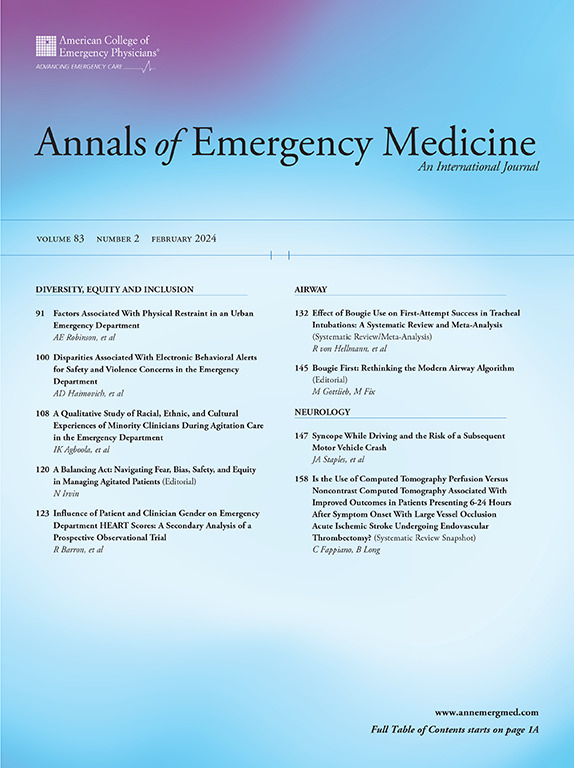转诊医院的门进门出时间与出血性脑卒中的预后。
IF 5
1区 医学
Q1 EMERGENCY MEDICINE
引用次数: 0
摘要
研究目的出血性脑卒中患者通常需要院间转运。指南建议转院急诊科(ED)的门进门出(DIDO)时间应≤120 分钟;然而,DIDO 时间是否与出血性卒中的临床预后有关尚不清楚:方法:使用《指南》-卒中参与医院的美国登记数据进行回顾性观察队列研究。患者包括从2019年1月1日至2022年7月31日期间从急诊室转入Get With The Guidelines参与医院的年龄≥18岁的脑内出血(ICH)或蛛网膜下腔出血(SAH)患者。主要结果是出院时修改后兰金量表(mRS)的顺序评分,次要结果包括出院时mRS的二分法、出院时独立行走的能力以及接收医院的院内死亡率:共纳入 19708 名 ICH 患者和 7757 名 SAH 患者。在未经调整的分析中,DIDO时间越长,ICH患者出院时mRS 0至3与4至6的几率越大(DIDO 91至180分钟,几率比[OR] 1.15 [1.04至1.27];DIDO 181至270分钟,OR 1.51 [1.33至1.71];DIDO >270分钟,OR 1.83 [1.58至2.11];DIDO≤90分钟)。在调整后的分析中,未观察到相关性。SAH患者出院时的mRS也有类似结果。在未经调整的分析中,对于 ICH 和 SAH 患者,较长的 DIDO 时间与较高的出院时独立行走几率和较低的院内死亡率几率相关。经过调整后,这些关联的效应大小减小,一些基于四分位数的结果在统计学上变得不显著:这些研究结果表明,急诊室目前正在加快转运病情最严重的患者;然而,要了解早期治疗和转运时机对出血性卒中患者的影响,还需要前瞻性研究和更详细的数据。本文章由计算机程序翻译,如有差异,请以英文原文为准。
Door-In-Door-Out Times at Referring Hospitals and Outcomes of Hemorrhagic Stroke
Study objective
Interhospital transfer is often required in the care of patients with hemorrhagic stroke. Guidelines recommend a door-in-door-out (DIDO) time of ≤120 minutes at the transferring emergency department (ED); however, it is unknown whether DIDO times are related to clinical outcomes of hemorrhagic stroke.
Methods
Retrospective, observational cohort study using US registry data from Get With The Guidelines–Stroke participating hospitals. Patients include those aged ≥18 years with intracerebral hemorrhage (ICH) or subarachnoid hemorrhage (SAH) who were transferred from the ED to a Get With The Guidelines participating receiving hospital from January 1, 2019, to July 31, 2022. The primary outcome was ordinal discharge modified Rankin scale (mRS) score and secondary outcomes included dichotomous discharge mRS, ability to ambulate independently at discharge, and inhospital mortality at the receiving hospital.
Results
In all, 19,708 ICH and 7,757 patients with SAH were included. For patients with ICH, an increasing DIDO time was associated with greater odds of mRS 0 to 3 versus 4 to 6 at discharge in the unadjusted analyses (DIDO 91 to 180 minutes, odds ratio [OR] 1.15 [1.04 to 1.27]; DIDO 181 to 270 minutes, OR 1.51 [1.33, 1.71]; DIDO >270 minutes, OR 1.83 [1.58, 2.11]; versus DIDO ≤90 minutes). In the adjusted analyses, no associations were observed. Similar results were seen for mRS at discharge in patients with SAH. In both patients with ICH and SAH, longer DIDO times were associated with greater odds of independent ambulation at discharge and lower odds of inhospital mortality in the unadjusted analyses. After adjustment, the effect sizes of these associations were reduced, with some of the results based on quartiles becoming statistically nonsignificant.
Conclusion
These findings suggest that EDs currently expedite the transfer of the sickest patients; however, prospective studies and more granular data are needed to understand the impact of early treatment and timing of transfer for patients with hemorrhagic stroke.
求助全文
通过发布文献求助,成功后即可免费获取论文全文。
去求助
来源期刊

Annals of emergency medicine
医学-急救医学
CiteScore
8.30
自引率
4.80%
发文量
819
审稿时长
20 days
期刊介绍:
Annals of Emergency Medicine, the official journal of the American College of Emergency Physicians, is an international, peer-reviewed journal dedicated to improving the quality of care by publishing the highest quality science for emergency medicine and related medical specialties. Annals publishes original research, clinical reports, opinion, and educational information related to the practice, teaching, and research of emergency medicine. In addition to general emergency medicine topics, Annals regularly publishes articles on out-of-hospital emergency medical services, pediatric emergency medicine, injury and disease prevention, health policy and ethics, disaster management, toxicology, and related topics.
 求助内容:
求助内容: 应助结果提醒方式:
应助结果提醒方式:


